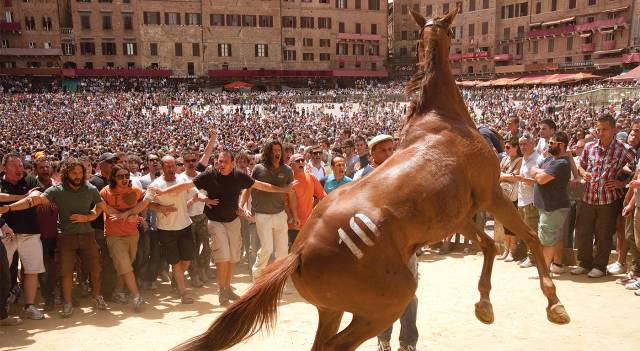
 In Palio director Cosima Spender highlights the unbreakable bond between the Palio and her home—Siena, Italy. The Palio is a horse race that was first run in 1238, and so the race is so steeped in history that it has become the city’s crowning tradition. The race is run twice a year, July 2nd and August 16th, in the Piazza del Campo where the residents, divided up into 17 ancient districts, each cheer for their horse to win. Each district has a committee that prepares all year long for the race, and will do anything to improve their district’s chances of winning. Residents are fiercely loyal their districts, and winning is taken extremely seriously.
In Palio director Cosima Spender highlights the unbreakable bond between the Palio and her home—Siena, Italy. The Palio is a horse race that was first run in 1238, and so the race is so steeped in history that it has become the city’s crowning tradition. The race is run twice a year, July 2nd and August 16th, in the Piazza del Campo where the residents, divided up into 17 ancient districts, each cheer for their horse to win. Each district has a committee that prepares all year long for the race, and will do anything to improve their district’s chances of winning. Residents are fiercely loyal their districts, and winning is taken extremely seriously.
The most important element in the Palio is the horse, since in this race, a riderless horse can win. This makes the jockey only the second-most important component. Being a jockey offers a person a chance at achieving maximum glory, but as we see in Spender’s film, much more likely is a jockey’s chance of failure. Everybody involved seems to truly love the horses, but Palio jockeys are only loved when they win. If a jockey loses, which all do except for one per race, they are despised. Sometimes crowds even turn violent against losers.
Professional Palio jockeys are like mercenaries; they ride for whichever district pays them. The horses for the race are drawn at random, so jockeys might end up on a completely unfamiliar horse, but this randomness is very controlled. This is what the districts' committees spend their time working on. There is a significant amount of bribery that happens on all levels of the race, and the film does a good job of describing it without condemning it. Jockeys can be bribed all the way up until the race starts.
Palio is composed very much like a scripted film. Scenes are polished and tight, there is tons of excellent racing footage, and there is a serious story arch as we follow the trajectory of the jockeys. Spender and her team follow two rival jockeys—13-time champion Gigi Bruschelli and challenger Giovanni Atzeni. She delves into their lives, documenting how Bruschelli rose to become reigning Palio king, and how Atzeni went from being a poor kid to a challenger for the title. The trajectory of the jockeys through the racing season is so exciting it seems like fiction. The filmmakers caught real magic on film here, giving light to both a tremendous racing season, and to one of the greatest cultural phenomena on the planet.